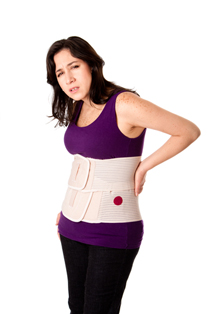
- $ 6,155,000 MEDICAL MALPRACTICE
- $ 2,500,000 MOTOR VEHICLE ACCIDENT
- $ 2,150,000 PREMISES LIABILITY
- $ 2,000,000 MEDICAL MALPRACTICE
- $ 2,000,000 WRONGFUL DEATH
- $ 1,910,000 CONSTRUCTION ACCIDENT
- $ 1,300,000 MOTORCYCLE ACCIDENT
- $ 1,300,000 MOTOR VEHICLE ACCIDENT
- $ 1,250,000 CONSTRUCTION ACCIDENT
Back Fracture, Sprain, & Strain Injuries
Back Fracture
A back fracture is a broad term used to describe a medical condition in which there is a break in the continuity of the thoracic and/or lumbar vertebrae. The thoracic portion of the back has 12 vertebrae and is between the cervical (neck) and lumbar portions of the spine. The lumbar vertebrae are between the thoracic and sacral portions of the spine.
Common Causes
A back fracture can occur from a high force impact or collision. Motor vehicle accidents and contact sports are two examples that might result in a high impact collision. X-rays, MRIs, bone scans, or CT scans may be required to verify whether or not you have a fractured spine.
Symptoms
Of the thoracic and lumbar spine:
- Spine Tenderness
- Back Stiffness
- Deformed Spine
- Increased Pain with Movement
Back Sprain & Back Strain
A back sprain is an injury in which there is a stretch or tear in the ligaments that are attached to the lower back and upper buttocks. Ligaments are bands or sheets of fibrous tissue that connect two or more bones or cartilages. They also serve as a support for fasciae or muscles.
A back strain is an injury in which there is a stretch or tear of the muscles or tendons connecting to the back. A tendon is a fibrous cord of muscle tissue that connects the muscles to the bones.
Common Causes
A back sprain or strain may result from:
- Car accident
- Pedestrian accident
- Slip and fall accident
- Improper lifting techniques
- Sports injury
- Being overweight and out of shape
Essentially, the soft tissue damage may be caused by inflammation from the initial injury to the lower back. The cardinal signs for inflammation are swelling, redness, pain, increased heat, and loss of function.
Symptoms
The following are symptoms of back sprain and strain:
- Lower back pain (especially when bending or stooping)
- Lower back spasms
- Lower back tenderness
- Redness and/or swelling of the lower back
Injury Consequences
Besides discomfort and pain, a back fracture, sprain, or strain may also cause some degree of difficulty in moving the back. Bending and stooping may cause you complications during daily routines at home and work. Depending on your job, it may be necessary to receive a note from the physician requesting light duty if bending or lifting is required.
Treatment
The RICE method is usually helpful in treating a fracture.
- R – Rest
- I – Ice
- C – Compression
- E – Elevation
If you have a back fracture, a back brace or support may be used until the fracture has healed. Using a back brace or support helps prevent your injury from worsening.
Non Steroidal Anti Inflammatory Drugs (NSAIDs), such as aspirin or acetaminophen, can also help you with the pain and swelling. Once the pain starts to subside, you will work on strengthening back muscles and using range of motion exercises for the back. Surgery is usually not required in a large amount of thoracic and lumbar spine injuries.
If you experience severe pain, a stronger pain medication may be used. A further evaluation may be necessary if your back is still not healing. At that point, the physician must determine if it is an issue of noncompliance or if other causes can be determined by X-rays, CT scans, MRIs, or bone scans.
Contact Us
Please call the Law Offices of Michael Cordova at (602) 265-6700, submit your case through our website Case Evaluation Form, or utilize our online Chat Service.
Law Offices of Michael Cordova
1700 N 7th St #1, Phoenix, AZ 85006
Phone: 602-265-6700
Hours: Mon - Thurs 8AM - 6PM; Fri 8AM - 5PM



